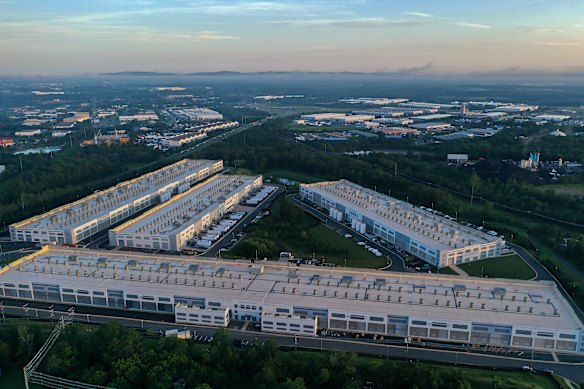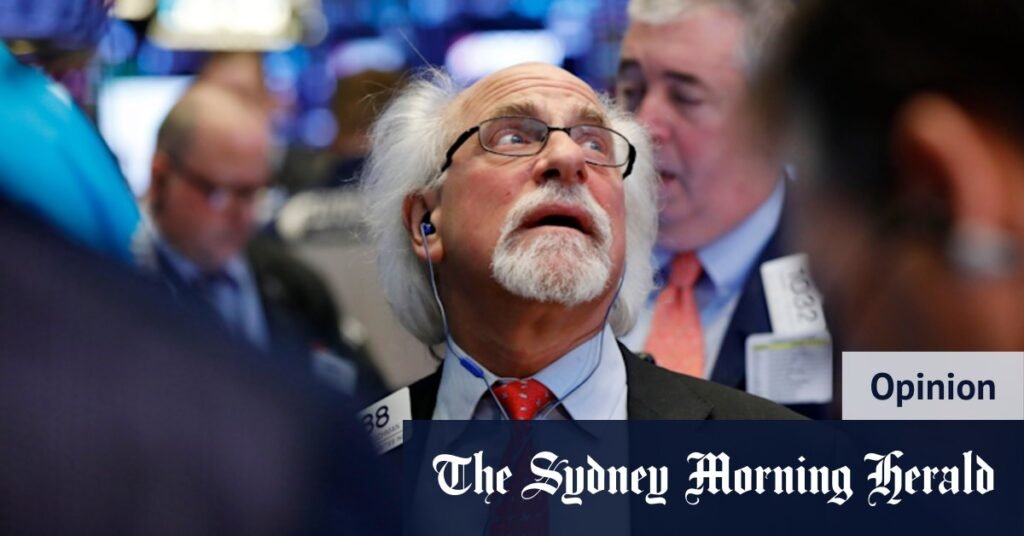Morgan Stanley research has said global data centre capacity will expand by 600 per cent by 2030. It has a lower estimate of what that will cost – $US3 trillion.
This year, hyperscalers are expected to invest about $US320 billion, compared to $US200 billion last year. By 2028, they will be investing more than $US300 billion in data centres and AI chips.

Data centres are popping up around the globe to power the AI boom.Credit: Bloomberg
Whether it is $US3 trillion or $US6.7 trillion, the scale of investment is staggering and is far out-running the revenues being generated. Last year, those hyperscalers generated only $US45 billion of AI-related revenue. By 2028, Morgan Stanley said, their revenues might exceed $US1 trillion.
That qualification – the “might” – is significant. Companies are pouring ever-increasing amounts of their shareholders’ funds into AI, based on very optimistic expectations of its potential revenues and margins and the development of applications that don’t currently exist.
Fierce competition to be one of those left standing and dominating the sector when the inevitable clean out occurs is fuelling an investment binge, although, at this admittedly very early stage of the sector’s development, the massive numbers of AI users aren’t translating into a material base of paying users.
Loading
The entity that sparked the boom, Open AI’s ChatGPT, for instance, has about 700 million weekly active users and that user base is growing at a dramatic rate – roughly four times its size last year.
It has, however, only about 5 million paying business users, and while that is growing rapidly, the conversion rate from free to paying users is less than impressive for a business valued in its most recent funding rounds at about $US300 billion.
By the end of this year, OpenAI is expected to generate revenue at an annualised run-rate of about $US20 billion. Earlier this year, the group agreed a deal with Oracle under which it will pay $US30 billion a year to lease 4.5 gigawatts of data centre computing power and another with Nvidia to buy $US40 billion of its most powerful chips. It is a cash and capital-devouring sector, on an unprecedented scale.
Most of the big players in AI would share broadly similar features with OpenAI. However, established mega techs like Amazon, Microsoft, Google and Meta Platforms may have the opportunity to commercialise AI within their existing customer base.
These massive investments are being made – the mega-techs are spending around $US100 billion each this year, with plans to spend more next year and beyond – without any firm understanding of the eventual demand or the returns.

The problem with market bubbles is you only know you are in one when they burst. Credit: AP
That hasn’t phased investors, who are ploughing funds into the sector at ever more dizzying valuations.
Elon Musk’s xAI, for instance, first raised money at a $US18 billion valuation in March last year. It raised more in December, at a $US50 billion valuation. By March this year, another raising saw its value increase to $US80 billion and, more recently, it was looking to raise funds at a valuation of up to $US200 billion.
Somehow, having raised about $US30 billion or so of debt and equity for an entity that is expected to burn about $US13 billion of cash this year and which doesn’t expect, if everything goes according to its plans, to be cashflow-positive before 2029, people are valuing it, with real money, at $US200 billion?
That’s what you’d call a very high-risk investment, particularly when you take into account xAI’s competitors in this race to AI supremacy, most of whom have massive cash flows from their existing operations to self-fund their AI plays. xAi’s valuations are effectively a capitalisation of Musk’s reputation.
Is the AI boom a bubble? We’ll only know if it bursts.
There are a couple of other features of the sector that raise question marks.
One is that, to date, the generative AI sector is overly reliant on expensive Nvidia chips. These are upgraded regularly, so a recurring and very substantial cost.
The other is that the multitude of data centres being built, and those that will have to be built to power the AI rollout, require huge amounts of power themselves.
The International Energy Agency has estimated that electricity demand from data centres will more than double by 2030. By that date, the US economy will consume more electricity for data processing than it now does for the manufacturing of all energy-intensive goods, including aluminium, steel, cement and chemicals.
A significant question is whether it is possible for the power requirements of those data centres to be met when AI firms need them, and at affordable prices, particularly in the US, where Joe Biden’s push for a surge in renewables has been aborted by Donald Trump.

ChatGPT has about 700 million weekly active users and that user base is growing at a dramatic rate.Credit: Getty
None of this is meant to question the potential of AI to ignite a new industrial revolution, transforming work and society.
Not all companies and their investors who risk such extraordinary amounts of capital in the hope of a commensurately large payoff will be successful. More likely, as occurred in the early 2000s, a handful of very large and dominant companies will emerge, with the rest (and their shareholders’ funds) disappearing.
Loading
There is a risk – as occurred in the late 1990s – that, at this point in its development, the sector is being over-hyped, attracting participants who won’t survive and being attributed valuations that will eventually prove ephemeral.
Is the AI boom a bubble? We’ll only know if it bursts.
The Market Recap newsletter is a wrap of the day’s trading. Get it each weekday afternoon.







